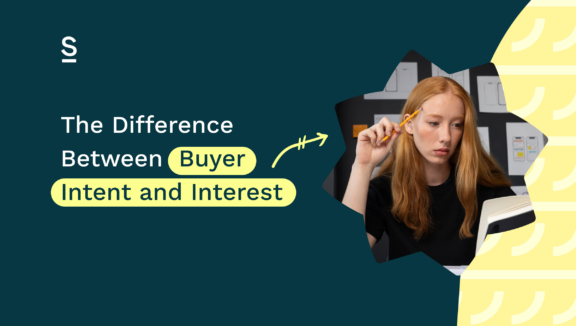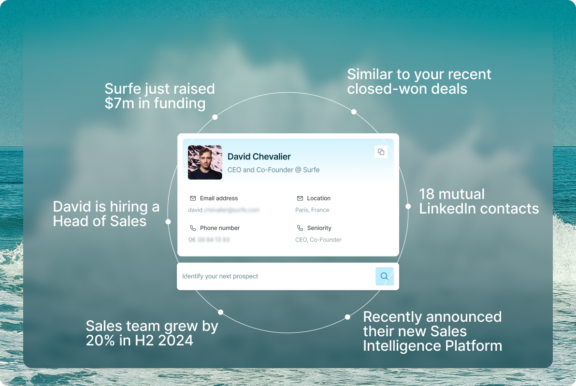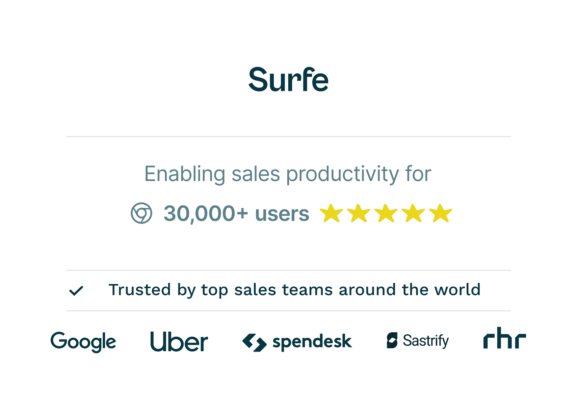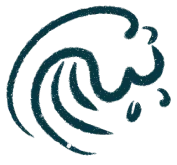The Difference Between Buyer Intent and Interest

The best way to understand the difference between buyer interest and buyer intent is to put yourself in the shoes of someone who’s going shopping.
Our imaginary friend doesn’t have a specific goal or item in mind. They wander up their local high street, and show their interest by looking in all the shop windows. At some point, they see a bag they really like in a window display. They head into the shop, check the price, and head to the till – which, as we’re sure you agree – shows a pretty strong intent to buy.
Get it? Good – but why is understanding the difference between buyer interest and buyer intent important in B2B sales?
Think about it this way: buyers that show strong buyer intent are going to be much easier to get over the line. In other words, they’re a high-quality prospect. Interested parties, on the other hand, might make a purchase – but there’s also a strong chance that they might not. You’ve only got so much time and energy in the day, so it makes much more sense to direct it towards the people more likely to buy.
If you’re nodding your head in agreement – clever you. Keep reading, and you’ll learn how to recognize buyer intent data against buyer interest data, and how to move all types of buyer along the funnel:
- What is Buyer Interest?
- What is Buyer Intent?
- How to Recognize Interest Triggers
- How to Detect Intent Signals
- Strategically Moving Buyers from Interest to Intent
- Striking at the Right Moment
- Closing the Deal
High conversion rates, here you come:
What is Buyer Interest?
Prospects showing buyer interest exhibit a degree of attraction to and excitement around your product. They’re probably further up the sales funnel – perhaps they’ve just become aware of their problem, or maybe they’re educating themselves on all possible solutions.
Typical signs of interest include website visits, content downloads, and social media engagement. The questions they ask will be geared more around comprehension – for example “Explain to me what you do?” or “What problem does this solve and why is it important?”.
It’s exciting to have a buyer interested in your product – but it’s not sufficient for closing a sale. You can think of these buyers as not yet having enough information to proceed to the next stage.
What is Buyer Intent?
Buyer intent, on the other hand, indicates that someone is actively looking to purchase from you.
Key indicators might be at a business level – they’ve just raised a funding round, their team is growing, some regulations have changed. You’ll probably see some of these in conjunction with personal intent indicators – their activity on your website, the type of questions they ask you, or the type of content they consume, for example.
Intent signals sit further down the funnel than interest signals. An interested party might spend a lot of time on your homepage or your About page, while a party with intent might spend more time on your pricing page or ROI calculator, for example.
The moment a prospect starts to show buyer intent is a critical one in the sales process. It’s a sign that someone is genuinely considering a purchase, and should be considered a high priority.

How to Recognize Interest Triggers
Early engagement shouldn’t be discounted – far from it. If a prospect visits your website more than once, or downloads some content, it’s a positive sign. The key here is to map their engagements so you can identify when they move over from the interest stage to the intent stage.
Surfe (heya) is a great tool for tracking interest indicators – for example, you could set it up to let you know every time someone engages with a certain amount of your content on LinkedIn. This means you don’t have to spend every waking hour following your prospects’ every move. Instead, the data you need is delivered to you – no effort required.
Tip: monitoring one channel isn’t enough here. Buyers undergo 90% of the buying journey before engaging with sales. It’s very unlikely all of this takes place in just one place.
How to Detect Intent Signals
Just as with interest signals, you can use clever tools and tech to track buyer intent data.
The best tools will combine behavioral and contextual cues that indicate strong intent.
If someone, say, visited your pricing page loads of times, and also worked at a company that was the same size as your typical customer, they would be marked as a hot lead.
It’s good practice to look out for both quantitative feedback (number of content downloads, for example) and qualitative feedback (if, say, the prospect asked you a question about the ROI their business could expect).
The best solution for you will be unique to your business (sorry!) – but make sure that the one you choose integrates with your CRM. Otherwise, you’ll still be doing half the manual work – sending emails, for example – that your CRM could handle. You’ll also want to look for something that can present its insights in an easily digestible way. Again, if you’re manually digging through a spreadsheet day after day, your tool’s made your life harder rather than easier.

Strategically Moving Buyers from Interest to Intent
So, how do we move interested buyers to the intent stage?
The answer, our friends, comes down to nurturing strategies. For example, if they download a gated piece of content, you might pop their email address into a 5-email educational flow. Once that’s finished, you might softly try to book a meeting – if no dice, they could be moved into a once a biweekly sales cadence.
The great thing about gathering buyer interest signals is that you know what to reach out to your prospects about. If they’ve left a comment on your last LinkedIn post, you could continue the conversation over email. Or if they’ve downloaded a case study, maybe your nurture cadence has details from what they’ve just read.
You can also motivate intent development with triggers like a limited-time offer. Used sparingly, these triggers can help gently shift the buyer over into a more intentional state.
What Is The Best Time To Contact A Potential Buyer?
That’s a good question! Really, it depends on what the strongest signs of buyer intent are for your unique business.
For example, your 3 biggest deals of last quarter may all have involved a CRO hired in the previous 6 months. If a prospect hires a new CRO, you can interpret that as a strong sign you should jump on it. For another business, the new CRO could mean next to nothing (no offense, imaginary CRO) for the deal.
It’s important to interpret your signals accurately too – we all get excited about a new website visitor, but in isolation it doesn’t mean much. Make sure not to jump the gun here. Getting in touch prematurely (or, for that matter, too late) can be the difference between a close and a loss.
We’d also recommend spending some time figuring out which communications can be automated, and which are best left to you. An initial email can usually be handled by your CRM, but a response to a prospect’s question? Far better to come from you.
How To Close The Deal
Ok – you’ve now moved a buyer from interest through to intent. Well done – you’re nearly there!
Now, time for the close. Follow best practices like keeping momentum high and communicating with all members of the buying committee.
As well as that, you might want to create a sense of urgency with a deal or offer (use these with caution!) or a personalized plan to move things over the line.
Confidently approach the deal and be assumptive – “Would you like me to send the contract today?” as opposed to “Would you like to sign a contract?” and you’ll get there in no time.
Let’s Wrap It Up!
Doesn’t your imaginary friend look nice with their new bag!
We love seeing people make a great purchase – and we’re sure you do too, particularly when said purchase involves something you’re personally selling. Listen to what your prospects are telling you and adjust your approach based on what you learn, and they’ll be moving through the funnel at the speed of light.
Better start thinking about what you’re going to buy with all that commission you’ve earned 😉

Hey – how are you going to contact your high-intent buyers?
Using Surfe – it finds you email addresses and phone numbers in a jiffy. Try it here.
FAQs About The Difference Between Buyer Intent And Interest
What Is the Difference Between Buyer Interest and Buyer Intent?
Buyer interest means a prospect is curious or excited about your product. Buyers at this stage are often learning about their problem, or exploring options to solve it. Buyer intent, on the other hand, shows a prospect is actively considering making a purchase. Interest might be reflected in website visits or social media engagement, while intent is seen in pricing page views or ROI-related questions. Understanding this difference helps sales teams focus on high-priority prospects more likely to convert.
Why Is It Important to Understand Buyer Interest and Intent?
Knowing the difference allows you to prioritize your time and resources effectively. Buyers showing intent are closer to making a purchase, making them high-quality leads. On the flip side, interested buyers may still need nurturing before they’re ready to buy. Focusing on intent helps improve conversion rates while understanding interest makes sure you don’t ignore potential customers.
How Can You Recognize Buyer Interest?
Buyer interest often manifests in early-stage behaviors, like visiting your website, downloading content, or engaging on social media. They may ask general questions such as “What problem does this solve?” or “What does your product do?” These signals indicate curiosity but don’t necessarily mean the buyer is ready to commit. Tracking these interactions helps you nurture leads until they display intent.
What Are the Signs of Buyer Intent?
Signs of buyer intent include behaviors like repeated visits to your pricing page, using an ROI calculator, or asking specific questions about cost and implementation. Contextual cues, like a company raising funding or growing its team, also signal intent. A mix of quantitative data (like site visits) and qualitative feedback (like ROI inquiries) helps identify when a prospect is ready to buy.
How Do You Move a Buyer from Interest to Intent?
The key is strategic nurturing. For example, send educational emails after a prospect downloads content, and follow up with tailored offers or meeting requests. Use triggers like limited-time deals sparingly to create urgency. Mapping buyer behavior across channels ensures you engage at the right moments, nudging interested prospects closer to purchase.


